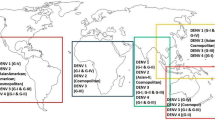Abstract
Communicable diseases, especially vector-borne diseases account for more than 17% of all infectious diseases, causing more than 700,000 deaths annually. Malaria and Dengue are the most predominant vector-borne diseases. According to WHO reports as of March 2020; Malaria cases are estimated around 219 million globally, and this results in more than 400,000 deaths every year. Most of the deaths occur in children under the age of 5 years. Dengue is the most prevalent viral infection with an estimated 96 million symptomatic cases and an estimated 40,000 deaths every year. The case count of dengue and other vector-borne diseases has been steadily increasing in the past decade. In this work, we propose a deep learning model called recurrent neural network (RNN) to predict future disease cases, which will be a great aid for the government to take preventive measures and for hospitals to cope with the increase in medical care demands. The trends of vector-borne disease are highly impacted by the climatic change in the region. Our model uses the past few years’ disease case data and climate data of Kerala to predict their future cases. Both the models showed excellent accuracy in predicting the cases up to the next 12 months. It has been observed that RNN performed the best on Dengue data, while SVR performed best for Chikungunya’s data compared to the other classifiers. A graphical user interface (GUI) has also been developed for the models, which provides a user-friendly application.
Access this chapter
Tax calculation will be finalised at checkout
Purchases are for personal use only
Similar content being viewed by others
References
Martheswaran TK et al (2022) Prediction of dengue fever outbreaks using climate variability and Markov chain Monte Carlo techniques in a stochastic susceptible-infected-removed model. Sci Rep 12(1):5459. ISSN: 2045-2322
Patil S, Pandya S (2021) Forecasting dengue hotspots associated with variation in meteorological parameters using regression and time series models. Front Public Health 9:798034
Anno S et al (2019) Spatiotemporal dengue fever hotspots associated with climatic factors in Taiwan including outbreak predictions based on machine-learning. Geospat Health 14(2)
Stolerman LM, Maia PD, Nathan Kutz J (2019) Forecasting dengue fever in Brazil: an assessment of climate conditions. PLOS ONE 14(8):1–16
Salim NAM et al (2021) Prediction of dengue outbreak in Selangor Malaysia using machine learning techniques. Sci Rep 11(1):939, ISSN: 2045-2322
Schneider R et al (2021) Climate-based ensemble machine learning model to forecast dengue epidemics. In: ICML 2021 Workshop on tackling climate change with machine learning, 2021
Zhao N et al (2020) Machine learning and dengue forecasting: comparing random forests and artificial neural networks for predicting dengue burden at national and sub-national scales in Colombia. PLOS Neglected Trop Dis 14(9):e0008056
Sarder F, Akter S, Akter S (2022) Predicting dengue outbreak from climate data using machine learning algorithms. In: 2022 IEEE International conference on data science and information system (ICDSIS). 2022, pp 1–6
Selvin S (2017) Stock price prediction using LSTM, RNN and CNN-sliding window model. In: International conference on advances in computing, communications and informatics (ICACCI). IEEE, pp 1643–1647
Aswiga RV, Shanthi AP (2022) A multilevel transfer learning technique and LSTM framework for generating medical captions for limited CT and DBT images. J Dig Imaging 35(3):564–580, ISSN: 1618-727X
Vinayakumar R et al (2018) Detecting android malware using long short-term memory (LSTM). J Intell Fuzzy Syst 34(3):1277–1288
Unnikrishnan A, Sowmya V, Soman KP (2019) Deep learning architectures for land cover classification using red and near-infrared satellite images. Multim Tools Appl 78:18379–18394
Author information
Authors and Affiliations
Corresponding author
Editor information
Editors and Affiliations
Rights and permissions
Copyright information
© 2023 The Author(s), under exclusive license to Springer Nature Singapore Pte Ltd.
About this paper
Cite this paper
Rajendran, N.M., Karthikeyan, M., Karthik Raja, B., Pragadishwaran, K., Gopalakrishnan, E.A., Sowmya, V. (2023). Communicable Disease Prediction Using Machine Learning and Deep Learning Algorithms. In: Ranganathan, G., Papakostas, G.A., Rocha, Á. (eds) Inventive Communication and Computational Technologies. ICICCT 2023. Lecture Notes in Networks and Systems, vol 757. Springer, Singapore. https://doi.org/10.1007/978-981-99-5166-6_66
Download citation
DOI: https://doi.org/10.1007/978-981-99-5166-6_66
Published:
Publisher Name: Springer, Singapore
Print ISBN: 978-981-99-5165-9
Online ISBN: 978-981-99-5166-6
eBook Packages: Intelligent Technologies and RoboticsIntelligent Technologies and Robotics (R0)




